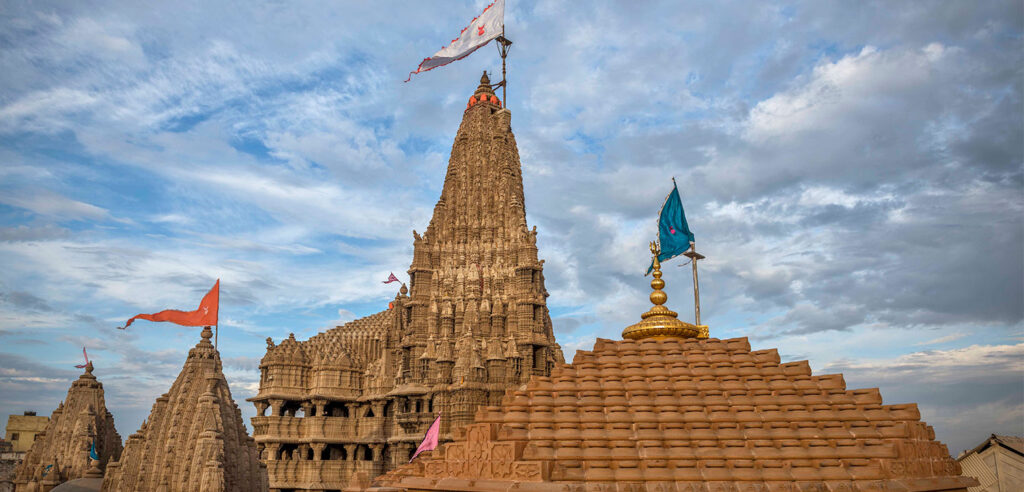
Dwarkadhish Temple Gujarat is a Hindu temple dedicated to Krishna, who is worshiped here by the name Dwarkadhish, or ‘King of Dwarka’. The temple is located at Dwarka city of Gujarat, India, which is one of the destinations of Char Dham, a Hindu pilgrimage circuit. The main shrine of the five-storied building, supported by 72 pillars, is known as Jagat Mandir or Nija Mandir.
Shree Dwarkadhish Temple Gujarat is one of the most important Hindu temples in India. It is a major pilgrimage destination, and is visited by millions of people each year. The temple is also a popular tourist destination, and is known for its beautiful architecture and its religious significance.
Shree Dwarkadhish Temple Timing
Here are the timings of Shree Dwarkadhish Temple:
Morning Darshan:
- Mangla Aarti: 6:30 AM to 7:00 AM
- Mangla Darshan: 7:00 AM to 8:00 AM
- Abhishek Puja (Snan Vidhi): 8:00 AM to 9:00 AM (Darshan Closed)
- Shringar Darshan: 9:30 AM to 9:45 AM
- Snanbhog: 9:45 AM to 10:15 AM (Darshan Closed)
- Shringar Darshan: 10:15 AM to 10:30 AM
- Shringarbhog: 10:30 AM to 10:45 AM (Darshan Closed)
- Shringar Aarti: 11:05 AM to 11:20 AM
- Gwal Bhog: 11:20 AM to 12:00 PM (Darshan Closed)
- Darshan: 12:00 PM to 1:00 PM
Evening Darshan:
- Uthappan Darshan: 5:00 PM to 5:30 PM
- Uthappan Bhog: 5:30 PM to 5:45 PM (Darshan Closed)
- Darshan: 5:45 PM to 7:15 PM
- Sandhya Bhog: 7:15 PM to 7:30 PM (Darshan Closed)
- Sandhya Aarti: 7:30 PM to 7:45 PM
- Shayanbhog: 8:00 PM to 8:10 PM (Darshan Closed)
- Darshan: 8:10 PM to 8:30 PM
- Shayan Aarti: 8:35 PM to 9:00 PM
- Darshan: 9:00 PM to 9:20 PM
- Bantabhog and Shayan: 9:20 PM to 9:30 PM (Darshan Closed)
- Darshan: 9:30 PM
On special days, such as Janmashtami, Holi, and Diwali, the temple timings may vary.
Historical Significance of Shree Dwarkadhish Temple
Archaeological findings suggest the original temple was built in 200 BCE at the earliest. The temple was rebuilt and enlarged in the 15th–16th century. According to tradition, the original temple was believed to have been built by Krishna’s grandson, Vajranabha, over the hari-griha (Krishna’s residential place). The original structure was destroyed by Mahmud Begada in 1472.

Architectural Marvels of the Shree Dwarkadhish Temple
The Dwarkadhish Temple Gujarat, standing tall in the holy city of Dwarka, Gujarat, is more than just a place of worship. It’s a dazzling display of architectural brilliance, seamlessly blending various styles and symbolizing profound spiritual significance. Let’s delve into some of its key marvels:
1. A Fusion of Architectural Styles:
Predominantly Solanki: The temple’s core structure exhibits the Solanki style, prevalent in Gujarat during the 12th-13th centuries. This style is characterized by intricate carvings, pillared halls, and towering shikharas (spires).
Chalukyan Influences: Elements of the Chalukyan style, known for its intricate sculptures and decorative motifs, are also visible, adding a layer of richness to the overall design.
Later Additions: The Sabha Mandap, also called Ladwa Mandap, showcases influences from the 15th-16th centuries, highlighting the temple’s evolution over time.
2. Towering Shikhara:
The main Shikhara, rising majestically above the sanctum sanctorum, is a sight to behold. Built in the Nagara style, it resembles a mountain peak, symbolizing the ascent towards spiritual enlightenment. The seven distinct stories are said to represent the seven ancient cities (Sapta Puri) of Hindu pilgrimage, with Dwarka itself being the base.
3. Intricate Carvings and Sculptures:
The temple walls and pillars are adorned with a captivating tapestry of carvings depicting mythological figures, scenes from epics like Mahabharata, and floral motifs. These intricate artworks not only enhance the visual appeal but also narrate stories and imbue the temple with a sense of cultural heritage.
4. Symbolic Significance:
Every element of the temple’s architecture holds symbolic meaning. The 72 pillars supporting the main shrine represent the 72 chief disciples of Krishna, while the five stories of the shikhara symbolize the five elements (earth, water, fire, air, and ether). The two doors to the sanctum, Swarg Dwar (gate of heaven) and Moksha Dwar (gate of liberation), represent the journey towards spiritual freedom.
5. Grandeur and Harmony:
Despite the diverse influences, the overall architecture of the Dwarkadhish temple exudes a remarkable sense of harmony. The various elements seamlessly blend together, creating a cohesive and awe-inspiring structure that reflects the grandeur of Hindu temple architecture.
Spiritual Importance and Pilgrimage
Beyond its physical grandeur, the Shree Dwarkadhish Temple Dwarka holds immense spiritual importance. Pilgrims embark on a sacred journey, seeking solace and a divine connection. The spiritual aura within the temple precincts invites devotees to immerse themselves in prayer, meditation, and rituals, fostering a profound sense of spirituality.
Festivals Celebrated at Dwarkadhish Temple
Dwarkadhish Temple Gujarat comes alive with vibrant celebrations throughout the year, each festival holding special significance and attracting devotees from all corners of the world. Here are some of the most prominent festivals celebrated at the temple:
1. Janmashtami: This is undoubtedly the most important festival at the Dwarkadhish temple, commemorating the birth of Lord Krishna. The temple transforms into a spectacle of lights, decorations, and joyous fervor. Special pujas, abhishekams (ritualistic baths), and cultural programs are held for days leading up to the main event. The highlight is the midnight darshan of the idol of Lord Krishna amidst chanting and joyous celebrations.
2. Holi: The festival of colors takes on a special meaning at the Dwarkadhish temple, symbolizing the playful relationship between Krishna and Radha. Devotees playfully throw colors on each other, singing bhajan and immersing themselves in the spirit of joy and unity.
3. Diwali: The festival of lights illuminates the Dwarkadhish Temple Gujarat with diyas and intricate rangoli designs. Special pujas are performed to Lakshmi, the goddess of prosperity, and Lord Krishna. The temple premises shimmer with an ethereal glow, creating a truly magical atmosphere.
4. Rath Yatra: This nine-day chariot festival celebrates the journey of Lord Krishna from Mathura to Dwarka. A majestic chariot carrying the idols of Lord Krishna, Balarama, and Subhadra is pulled by devotees through the streets of Dwarka, creating a vibrant and energetic procession.
5. Vaman Jayanti: This festival marks the birth of Lord Vamana, an avatar of Lord Vishnu. Special pujas and abhishekams are performed to the idol of Lord Vamana, seeking blessings for knowledge and wisdom.
6. Dussehra: This ten-day festival celebrates the victory of good over evil, culminating in the burning of the effigy of Ravana. At the Dwarkadhish Mandir, special pujas and cultural programs are held, emphasizing the triumph of righteousness.
7. Sharad Purnima: This full moon night in the autumn month of Sharad is celebrated as a time of love and devotion. Devotees offer prayers and perform rituals seeking blessings for a happy and prosperous life.
Stories and Legends Associated with Dwarkadhish
The Dwarkadhish Temple Dwarka and the city of Dwarka itself are steeped in rich mythology and folklore, offering captivating stories and legends that intertwine with the temple’s history and significance. Here are a few captivating stories and legends associated with the Dwarkadhish Temple:
1. The Rise and Submersion of Dwarka:
Legend has it that Lord Krishna himself built the city of Dwarka after reclaiming land from the sea god Samudradeva. However, after Krishna’s departure from the Earthly realm, the city was said to have been submerged by the sea again, fulfilling Samudradeva’s promise. The present temple is believed to be built over the original structure, marking the seventh incarnation of Dwarka.
2. Victory over Shankhasura:
One famous legend tells the tale of Lord Krishna’s battle against the fearsome demon Shankhasura. Wielding a powerful conch shell, Shankhasura terrorized the gods and humans alike. Lord Krishna, in his divine avatar, engaged in a fierce battle and ultimately emerged victorious, taking the conch shell as a symbol of his triumph. This conch shell is said to resonate within the temple walls, reminding devotees of Krishna’s valor.
3. Rukmini’s Devotion and Marriage:
Another cherished legend recounts the love story of Krishna and Rukmini. A princess devoted to Krishna, Rukmini chose him as her husband despite being promised to another king. The legend of ‘Rukmini Harana’ narrates how Krishna whisked Rukmini away on his chariot, symbolizing their divine union. The Dwarkadhish temple serves as a testament to their love, reflected in its architecture and rituals.
4. Meera Bai’s Eternal Devotion:
The legendary story of Meera Bai, a Rajput princess renowned for her unwavering devotion to Krishna, is deeply intertwined with the Dwarkadhish Temple Dwarka. It is believed that Meera Bai transcended the physical realm and merged with the idol of Lord Krishna within the temple, signifying the ultimate union of devotee and deity.
5. The Miraculous Door:
The two doors leading to the sanctum sanctorum of the temple, known as Swarg Dwar (doorway to heaven) and Moksha Dwar (doorway to liberation), hold a captivating legend. While Swarg Dwar remains open throughout the day, Moksha Dwar opens only on special occasions. Legend states that only those with pure hearts and unwavering devotion can witness the opening of Moksha Dwar, symbolizing the threshold to spiritual liberation.
Rukmini Devi Temple and Gomti Ghat
Adjacent to the Dwarkadhish Mandir Dwarka, the Rukmini Devi Temple and Gomti Ghat offer additional spiritual sites for pilgrims. Rukmini Devi Temple is dedicated to Lord Krishna’s consort, and Gomti Ghat is a sacred bathing spot on the banks of the Gomti River.
Significance of Dwarka in Hindu Mythology
Dwarka holds a pivotal place in Hindu mythology as one of the Sapta Puri, the seven sacred cities. Its association with Lord Krishna and the Mahabharata makes it a place of historical and religious importance, drawing scholars and devotees alike.
Pilgrimage Experience on Dwarkadhish Temple
Going to the Shree Dwarkadhish Temple isn’t just a trip; it changes you in a deep way. The special feeling around the temple and the way things are done there leave a lasting impression on everyone who visits.
Visitor Facilities and Amenities
To enhance the pilgrimage experience, the temple provides various facilities such as accommodation, dining, and guided tours. Pilgrims are welcomed with warmth, ensuring their visit is not just spiritually fulfilling but also comfortable.
Cultural and Social Impact
Beyond its religious significance, the Dwarkadhish Temple Gujarat has a profound impact on the cultural and social fabric of the region. Festivals and pilgrimages foster community bonds, and the temple serves as a cultural hub where traditions are celebrated and passed down through generations.
How to Reach Shree Dwarkadhish Temple
Here are the different ways you can reach Shree Dwarkadhish Temple Dwarka:
By Air:
- The nearest airport to Dwarka is the Porbandar Airport (PBD), which is approximately 95 km away.
- Another option is the Jamnagar Airport (JGA), which is approximately 145 km away.
By Train:
- Dwarka has its own railway station, Dwarka Railway Station (DWK).
- The station is well-connected to major cities in India, such as Delhi, Mumbai, and Ahmedabad.
By Road:
- Dwarka is well-connected to other cities in Gujarat by road.
- You can take a state-run bus, a private bus, or a taxi to Dwarka.
- The journey from Ahmedabad to Dwarka is approximately 470 km and takes about 10 hours.
FAQs (Frequently Asked Questions)
Q. Is photography allowed inside the Dwarkadhish Temple?
Ans. Yes, photography is allowed in specific areas, but it’s advisable to check with the temple authorities for any restrictions.
Q. What is the significance of the Gomti Ghat near Dwarkadhish Temple?
Ans. Gomti Ghat is considered a sacred bathing spot, and it is believed that taking a dip in the Gomti River purifies the soul.
Q. Are there any specific dress code requirements for visitors to the temple?
Ans. While there isn’t a strict dress code, it’s recommended to dress modestly out of respect for the religious sentiments.
Q. How can one participate in the Janmashtami celebrations at Dwarkadhish Temple?
Ans. Visitors are welcome to join the Janmashtami celebrations, which typically include cultural events, processions, and special prayers. Check the temple schedule for specific details.
Q. What are the nearby attractions worth exploring in Dwarka?
Ans. Apart from the Dwarkadhish Temple Gujarat, visitors can explore the Rukmini Devi Temple, Bet Dwarka, and the Nageshwar Jyotirlinga Temple.


